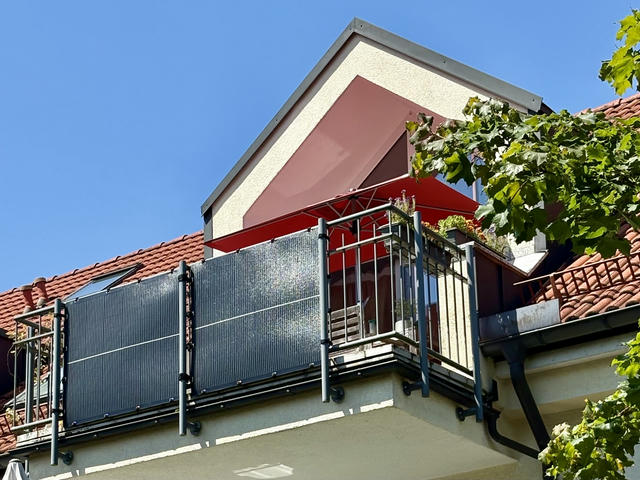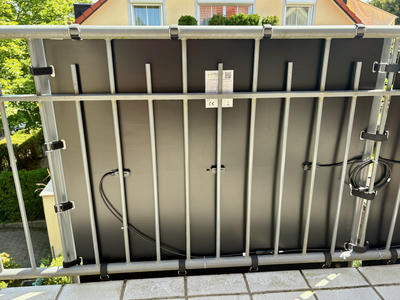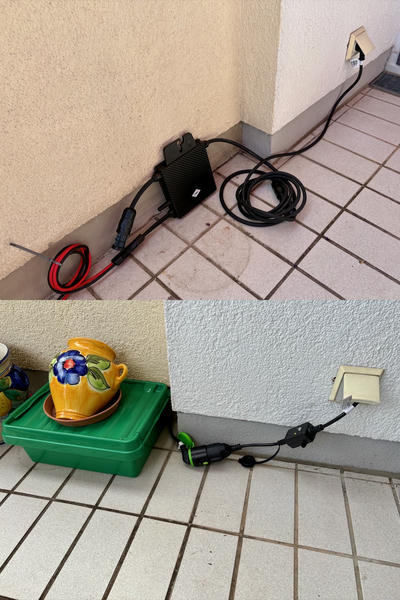Power to the People: What 45 days of balcony solar taught me about climate action

It’s December 2024. I’m at AWS re:Invent in Las Vegas, coaching speakers on how to communicate effectively with technical audiences. Meanwhile, 9,258 kilometers away in Munich, a room full of homeowners is debating whether my 7.6-kilogram solar panels will blow off my balcony in the wind.
This story is about 20 months of bureaucratic persistence—from inspiration at Christmas 2023 to August 2025 installation. The actual hardware setup was done in three hours on a Wednesday afternoon. The approval process? An odyssey of patiently waiting, engineering creativity, and refusing to give up.
Here’s what those 20 months taught me: meaningful climate action isn’t blocked by technical complexity—it’s blocked by inertia and giving up too soon.
Here’s how I stopped waiting for perfect conditions, what 45 days of real data revealed about generating my own clean energy, and why you should start this process today—not tomorrow.
The Christmas revelation
Christmas 2023. I’m visiting my friend Rolf Kersten, and he shows me his “Balkonkraftwerk” (the German word for “balcony power plant”) which he had set up about half a year before. Not on a balcony, actually, he owns a row house, but he chose solar panels hanging from his bedroom window over a traditional rooftop installation for simplicity.
“Wait,” I said, “you’re generating your own electricity and pumping it into your standard power socket? Just like that?”
He showed me his Home Assistant dashboard. Real-time power generation. Daily totals. Pretty graphs. The whole thing cost less than a laptop and was generating nearly 200 kWh per year.
I’d been reading about climate change, ran the numbers for my family, done what we could to reduce our CO2 footprint, and bought certificates to compensate for the rest. But this? This was measurable action, beyond my energy provider’s “green” tariff.
Generating clean energy for real, and tracking every single watt.
As a tech person who spent 27 years in IT infrastructure, if there’s one thing I understand, it’s systems, and the power of measurement. Rolf showed me that even mortal apartment renters like me could join the solar revolution.
The timeline nobody warns you about
The German law landscape is favorable towards solar, so here’s what I expected: Ask landlord. Get approval. Order panels. Install. Generate power. Celebrate!
Here’s what actually happened:
January 2024: My landlord responds to my email within days. “Sure, no problem! But let me check if we need to run this by the Hauseigentümerversammlung (Homeowners Association, HOA).“
Turns out we had to. Easy enough, right?
Summer 2024: I contact my neighbours (who own their apartment) and the Hausverwaltung (property management). “When’s the next HOA meeting?”
“We don’t know yet. The last one was October 2023.”
Wait. October 2023? That’s… that was before I even thought about this project. And nobody knows when the next one is? Welcome to German bureaucracy 🇩🇪.
I tried pushing for an earlier decision. The Hausverwaltung wouldn’t budge. “You’ll have to wait for the next regular meeting.”
So I waited.
December 2024: The HOA finally meets. I’m in Las Vegas at AWS re:Invent, coaching speakers on stage presence and storytelling while my landlord heroically attends and advocates for my project.
The HOA’s verdict? Approved! But with conditions:
- Black color panels ✅ (I’d already chosen these)
- Proof of insurance coverage ✅ (already covered by my Haftpflichtversicherung, my personal liability insurance)
- Adherence to electrical standards ✅ (sure, because I usually love to electrocute myself 🙄)
- Registration with Marktstammdatenregister ✅ (because everything needs to be properly filed and in order)
- One more thing: “unter der weiteren Auflage, dass nachgewiesen wird, dass das Balkongeländer die Windlast verträgt, die durch die angebrachte Fläche der Solarzellen auf das Geländer wirkt”
(Record scratching sound here.)
Translation: Prove that the balcony railing can handle the wind load from the solar panel surface area.
Wait… what?
They suggested getting a “Handwerkerbescheinigung”—a craftsperson’s certification. But: what craftsperson in their right mind would certify something they didn’t build? Nobody wants that liability.
January-July 2025: I sat on this problem. And procrastinated. And worried about whether I was even approaching this correctly. How do you prove structural integrity without hiring an engineer (expensive!) or finding a Handwerker willing to certify (impossible!)?
During this time, I was also preparing for my biggest career transition—leaving AWS after 13 years to become a freelance consultant. The solar project became one more thing on a very long list.
Then I had a realization: I’m an engineer. Not the structural kind, but close enough. What if I did the math myself?
August 2025, installation day! Three hours on a Wednesday. Velcro straps (yes, really—they’re industrial-strength and part of the certified mounting system). Some cable management. Done.
I ended up buying some extra stuff (see below), but the tech part is indeed the easiest one.
September 2025: After technical bliss (and a vacation), it’s time to confront the bureaucratic reality. I spent a weekend researching wind load calculations, German building codes, and physics I hadn’t touched since university.
The calculation went like this:
- Munich is in Wind Zone 2 (according to DIBt regulations)
- Wind Zone 2 means 0.39 kN/m² wind pressure (from tables published by a company called OBO Bettermann )
- My panels: 2.325 m² total surface area (datasheet here)
- Hence, the maximum wind force is: 0.39 × 2.325 = 0.907 kN
- Converting to something tangible: 0.907 kN ÷ 9.81 m/s² = 92.46 kg
In other words, the maximum wind force on my solar panels would be equivalent to the gravitational force of a 92.46 kg object resting on the railing.
My balcony railing has three steel tubes, each 5 cm in diameter. I was pretty confident they could handle that. Also, my neighbor downstairs has a balcony privacy screen that probably has a similar weight, offers a larger wind attack surface, and has been there for years without issues 🙄.
I wrote up my analysis, included photos, specifications, and certifications, and sent it to the Hausverwaltung. Full letter here (anonymized, in German, with English translation).
I haven’t heard from the HOA since. I guess they just filed it away? I consider that a win: sometimes silence means acceptance in German bureaucracy 😅.
Twenty months from inspiration to installation. But only because I didn’t give up when the Handwerker problem seemed unsolvable.
The lesson? Start your landlord and HOA approval process today—before you buy anything. And when bureaucracy throws you an impossible requirement, get creative. Sometimes the solution is just doing the (paper)work yourself.
The setup: simpler than you think

The hardware I chose: Plugin Energy AIR superLIGHT HC 440W COMBO.
Why these panels?
- Lightweight: 3.8 kg each, 7.6 kg total, easy to transport
- Frameless: sleek, all-black design to satisfy the HOA
- Flexible: easier to mount on railings than rigid glass panels, easy to remove if I change home
- No glass, no shards, no hurt
- 440W total max. capacity: 220W per panel
The kit included a TSUN TSOL MX500 microinverter (converts DC from panels to AC for my home) and everything needed for connection. Total cost: €519 for the kit.
I added a few extras:
- FI-Schutzschalter (residual current device): €15 for extra safety, thanks to Rolf for suggesting this!
- Weatherproof green plastic box: €30 to keep the inverter dry and connections tidy
- Weatherproof Tasmota smart plug: €19 to measure actual output
- Extra solar power cables: €19 to put the inverter closer to the wall socket
- Total investment: ~€600
Installation was simple. The panels attach to the balcony railing with industrial-strength velcro straps that are surprisingly robust—they’re part of the certified mounting system. Plug the panels into the microinverter (with the extra cable), put the microinverter into the weatherproof box, connect to my balcony outlet. Done.
Well, almost done.
The TSUN inverter comes with its own app and monitoring. But other than the manufacturer’s app, there’s no other way to get the data. So I added a Tasmota smart plug between the outlet and my system to measure the actual power flowing into my home.
Setting up Tasmota + Home Assistant took some tinkering: calibrating the power measurements and configuring an MQTT broker, before I could harvest my data and create dashboards. You don’t really need this, the TSUN app works fine for most people. I just happen to be a data nerd who enjoys rabbit holes 🤓.
Three hours from zero to generating power. Twenty months to get permission to spend those three hours.
What the data reveals
Meanwhile, I have forty-five days of real data, from actual electrons flowing into my home power grid, measured by an independent meter.
(It still boggles my mind thinking that those power sockets can actually work backwards, too!)
The numbers:
- Total generation: 35.88 kWh over 45 days
- Daily average: ~800 Wh (0.8 kWh)
- Projected annual: 292 kWh
- Value at €0.37/kWh: ~€108 per year
- Return on investment: 5-6 years
- After that: pure profit for 20+ years
- CO2 avoided: 292 x 321 g CO2eq/kWh = 93.732 kg per year (based on Germany’s 2024 power grid mix, according to data from Nowtricity)

I’m not sure what will happen over winter: snow might cover my panels and the days will be shorter, but then again, the sun’s angle might be more favorable. I’ll find out!
But the numbers only tell part of the story. Here’s what surprised me:
Weather makes a huge difference. On the best days (clear sunny summer days), I generated over 1.5 kWh. On overcast days sometimes just 30-80 Wh. That’s quite a difference. Munich’s weather is… variable.
The dopamine effect is real. I love checking my Home Assistant dashboard. How much did yesterday generate? Is today sunny? How much is this measured in heated water kettles or laptops charged? This Grist.org article mentioned this phenomenon—people screenshot their daily yields and share them in family WhatsApp groups. I’ve done the same (though I prefer Threema for private messaging). It’s gamification for sustainability ☀️.
Neighbors ask questions. People I know start asking me about the panels, including my neighbour and of course my landlord. I can’t wait to see more of these popping up in my neighbourhood.
The data validates the 20 months of patience 😅.
Why this matters more than €100 per year
Let’s be honest: €108 per year isn’t life-changing money. At current electricity prices and my current usage, this system will pay for itself in 5-6 years. Then it’s profit for another 15-20 years (panels are warrantied for 25 years).
But this was never about the money.
Germany now has over 550,000 Balkonkraftwerke installed, with half of those added just in 2023-2024. That’s a movement. And movements aren’t driven by ROI calculations—they’re driven by something deeper.
The Grist article quotes someone who perfectly captured what I’m feeling: “It’s a small step you can take as a tenant” and an act of “self-efficacy, to not just sit and wait until the climate crisis gets worse.”
That’s it exactly. Agency.
For years, I felt climate anxiety. Read the reports. Worried about my carbon footprint. Recycled diligently. Chose “green” energy from my provider. But I never knew if any of it actually mattered.
Now? I know. 35.88 kWh over 45 days. That’s 35.88 kWh that didn’t come from natural gas or coal. That’s ~11.5 kg of CO2 I didn’t emit. It’s measurable. It’s real. It’s mine.
If that sounds like a drop in the ocean, it maybe is. But here’s the multiplier effect: Rolf inspired me at Christmas 2023. I’m writing this in October 2025. How many people will read Rolf’s post, or the Grist.org article or this one and start their own journey? One becomes two becomes five becomes twenty.
This is how movements start. One balcony at a time.
Should you do this?
Hell yeah if:
- You have a balcony facing south, east, or west (south is best, but east/west work too)
- You’re comfortable with basic tech (or willing to learn—it’s easier than you think)
- You want measurable climate action, not just good intentions
- You’re prepared to be patient with bureaucracy (it’s worth it!)
Maybe not (yet) if:
- Pure north-facing balcony, or no sunshine available (find a better place!)
- Very low baseline electricity consumption (you’ll end up feeding more to the grid without compensation)
- Completely unreasonable landlord/HOA (though German law is increasingly on your side)
As you see, not that many excuses left.
What I’d do differently:
- Start the landlord/HOA process FIRST, before buying hardware. Don’t assume it’ll be quick.
- Set realistic expectations: Approval can take 6-12+ months. Installation takes 3 hours.
- Budget for some extras: Plan for ~€50-100 beyond the base kit (safety switches, weatherproofing, extra cables, monitoring if you want).
- Join local communities: There are fantastic Balkonkraftwerk forums and groups where people share their experiences and troubleshoot together.
- I should have joined the movement earlier!
Your playbook to get started:
- Email your landlord TODAY. Don’t wait. Even if you’re not ready to buy, start the conversation. Use my experience: “This is now legal, HOAs must approve with reasonable conditions, here’s what I’m planning.”
- Find out when the next HOA meeting is. If it’s months away, ask if there’s a way to get preliminary approval or add it to the agenda early.
- Research hardware while you wait. Check your balcony orientation. Measure your space. Look at options. But don’t buy yet—approval first!
- Prepare your case. Gather information: insurance confirmation, product certifications, Marktstammdatenregister info. Make it easy for the HOA to say yes. Use my letter as a template.
- Order once approval is likely. The hardware doesn’t take long to arrive, but the approval process does.
- Install! This is the easy part. Seriously. Three hours.
- Set up monitoring (optional but fun). The manufacturer app works fine. If you want to go deeper, many smart plugs, like the Tasmota-based ones come with energy monitoring built-in, that you can tap into.
- Share your data! Blog about it. Post in forums. Tell your neighbors. Help grow the movement.
Resources that helped me:
- Rolf Kersten’s Balkonkraftwerk journey - The inspiration for my project
- Plugin Energy - Where I bought my system, recommended to me by Rolf (no affiliation)
- Article on Grist.org about Germany’s Balkonkraftwerk movement - Great context on the bigger picture
- My property management/HOA email template - Full text here
The sun is already shining on your balcony
The real win isn’t the money or even the carbon savings. It’s the proof that you don’t need to own a house to generate clean energy. You don’t need perfect conditions. You don’t even need to skip the bureaucratic headaches. You just need to refuse to give up when the process gets tedious.
It took 20 months from Christmas inspiration to August installation. But my panels will generate clean power for 20+ years.
The question isn’t whether you should do this. The question is whether you’re starting the process today and see it through when it gets bumpy.
Because here’s what I learned: Climate action isn’t blocked by complexity. It’s blocked by inertia and giving up too soon. The hardware is surprisingly simple. The approvals are getting easier (German law now mandates HOAs must approve these with reasonable conditions). The investment pays for itself. The impact is measurable.
The bureaucracy might test your patience. You might spend more time on paperwork than installation. You might have to calculate wind forces like I did. But on the other side is a bit of self-harvested clean energy, every single day, from your own balcony.
Your homework starts now:
- Check your balcony orientation (which direction does it face?)
- Draft that email to your landlord (today, not tomorrow)
- Join a local Balkonkraftwerk forum or Facebook group or find other Balkonkraftwerk friends to team up with
- Start researching kits and options
- Calculate your potential ROI
The sun is already shining on your balcony right now, while you read this.
What are you waiting for? ☀️⚡
What’s your experience with Balkonkraftwerke? Did you face similar bureaucratic challenges? Share your comments and/or story on this Bluesky update or this Mastodon thread!
